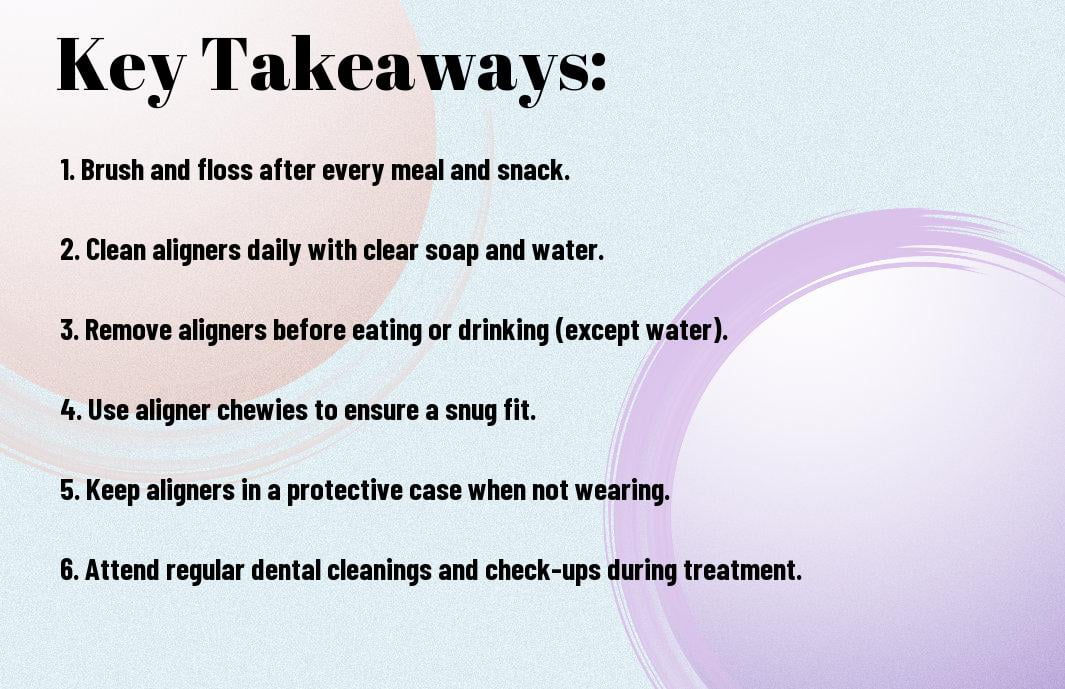It’s time to probe a whimsical world where your clear aligner treatment meets oral hygiene! Keeping your pearly whites sparkling clean requires a bit of finesse and care while rocking those aligners. From brushing techniques to choosing the right tools, we’ve got you covered with handy tips and tricks to ensure your smile stays bright throughout your journey. So, put on your invisible aligners and let’s commence on this oral care adventure together!
Key Takeaways:
- Consistency is key: Remember to brush your teeth after every meal to keep your aligners and teeth clean and healthy.
- Keep your aligners clean: Use a soft-bristled toothbrush and clear antibacterial soap to gently clean your aligners regularly.
- Stay hydrated: Drinking plenty of water helps prevent dry mouth and keeps your mouth clean and fresh while wearing clear aligners.
Pre-Treatment Preparation
Choosing the Right Aligners
The first step in maintaining oral hygiene during clear aligner treatment is selecting the right aligners for your needs. When choosing your aligners, make sure to consider factors such as the severity of your misalignment, your lifestyle, and your budget. Consult with your orthodontist to determine which type of aligners will work best for you.
Getting Familiar with Your New Smile
Any journey to a straighter smile begins with getting familiar with your new aligners. Your orthodontist will provide you with detailed instructions on how to wear and care for your aligners. Remember to wear them for the recommended amount of time each day and only remove them when eating or brushing your teeth. It may take some time to adjust to the feeling of the aligners in your mouth, but soon you will become accustomed to them.
This process of getting used to your new smile is necessary for the success of your treatment. Embrace the changes and be patient with yourself as you adapt to wearing aligners. Recall, each step you take brings you closer to a healthier, straighter smile!
Daily Hygiene Habits
Some crucial habits to maintain during clear aligner treatment involve daily oral hygiene practices. Ensuring that you prioritize brushing and flossing with aligners, using interdental brushes for tight spaces, and rinsing with mouthwash can help keep your teeth and aligners clean throughout the treatment.
Brushing and Flossing with Aligners
Brushing your teeth regularly is important when undergoing clear aligner treatment. Make sure to brush your teeth after every meal and before reinserting your aligners to prevent food particles from getting trapped. Flossing is also important to remove plaque and debris from between your teeth, helping to prevent cavities and gum disease.
Using Interdental Brushes for Tight Spaces
With aligners in place, you may find it challenging to clean tight spaces between your teeth. Using interdental brushes can be beneficial in these situations. These small brushes are designed to fit between teeth and can help remove plaque and food particles that regular brushing may miss.
The use of interdental brushes is particularly helpful if you have gaps, crowding, or tight spaces that are difficult to clean with traditional floss. By incorporating interdental brushes into your oral hygiene routine, you can ensure thorough cleaning and maintain the health of your teeth and gums.
Rinsing with Mouthwash for Extra Cleanliness
Tighten your oral hygiene routine by incorporating mouthwash into your daily regimen. After brushing and flossing, rinsing with a fluoride or antiseptic mouthwash can help kill bacteria, freshen your breath, and provide extra protection against cavities. Mouthwash can reach areas that a toothbrush or floss may miss, helping to ensure a thorough clean for your teeth and aligners.
Brushes with bristles that are designed to reach between teeth can also be a helpful tool in maintaining oral hygiene during clear aligner treatment. These brushes can effectively clean areas that are difficult to reach with traditional brushing and flossing, promoting overall dental health throughout your treatment.
Aligner Care Essentials
Many congratulations on choosing clear aligners to straighten your teeth! To ensure that your treatment progresses smoothly, it’s necessary to take good care of your aligners. Here are some necessary tips to keep your aligners clean and in good condition throughout your treatment:
Cleaning Your Aligners with Soap and Water
To keep your aligners clean and free of harmful bacteria, it’s crucial to clean them regularly. One simple and effective way to clean your aligners is by using a soft-bristled toothbrush and mild soap. Gently brush your aligners with the soap and water solution, making sure to rinse them thoroughly afterward. Avoid using hot water, as it can warp the plastic material of the aligners.
Avoiding Harsh Chemicals and Abrasives
The material used to make your aligners is sensitive to harsh chemicals and abrasives that can damage or discolor them. The last thing you want is to compromise the effectiveness of your treatment by using the wrong cleaning products. Be sure to steer clear of mouthwash, toothpaste, or any cleaning agents that contain alcohol, bleach, or harsh abrasives. Stick to gentle cleaning methods to maintain the clarity and integrity of your aligners.
The integrity and appearance of your aligners can be affected by the use of harsh chemicals and abrasives, so it’s vital to follow the manufacturer’s recommendations for cleaning. Using the wrong products can result in discoloration, warping, or even breakage of your aligners, extending your treatment time and possibly incurring additional costs for replacements.
Storing Your Aligners Properly When Not in Use
For optimal care and hygiene, it’s necessary to store your aligners properly when you’re not wearing them. Store your aligners in their case when they’re not in your mouth to prevent loss or damage. Avoid leaving them out in the open where they can collect dust, bacteria, or be accidentally thrown away. Always carry your aligner case with you when you’re on the go, so you have a safe place to store them when you need to take them out, such as during meals or when brushing your teeth.
Aligners need to be stored properly to maintain their shape and clarity. Leaving them exposed or in a napkin can lead to misplacement or damage, disrupting your treatment plan. By storing your aligners in their case when not in use, you’ll ensure that they remain clean and safely protected until it’s time to put them back in your mouth.
Managing Food and Drink
Eating with Aligners: Do’s and Don’ts
Despite the temptation to snack all day long, it’s imperative to be mindful of what you eat while wearing clear aligners. On one hand, hard and sticky foods can damage or get stuck in your aligners, prolonging your treatment time. On the other hand, opting for softer, healthier options like fruits and vegetables can help maintain your oral hygiene and keep your aligners clean.
Avoiding Staining Foods and Beverages
Beverages such as coffee, tea, and red wine, as well as heavily pigmented foods like curry or berries, can cause your aligners to become discolored over time. With proper care, you can minimize these effects and ensure your aligners remain clear throughout your treatment.
Tips for Drinking with Aligners
With aligners in place, it’s crucial to be cautious when drinking colored or sugary beverages. Staining liquids can seep into the aligners, leading to discoloration and potential hygiene issues. To prevent this, it’s best to stick to water whenever possible.
- Avoid drinking colored or sugary beverages while wearing aligners.
- Rinse your mouth with water after consuming staining drinks to reduce the risk of discoloration.
More on Avoiding Staining Foods and Beverages
For instance, if you do indulge in a staining beverage, make sure to brush your teeth and rinse your aligners immediately afterward. Thou will thank yourself for the extra effort in maintaining the clarity of your aligners.
Dealing with Common Issues
Handling Aligner Discomfort and Irritation
Common issues such as discomfort and irritation may arise while wearing clear aligners. If you experience any of these problems, don’t fret, for there are simple solutions to make your journey more comfortable. To alleviate discomfort, you can try using orthodontic wax to smooth out any rough edges on the aligners that may be causing irritation to your gums and cheeks.
Managing Plaque and Tartar Buildup
Managing plaque and tartar buildup is crucial to maintain good oral hygiene during clear aligner treatment. It is common for plaque to accumulate around the aligners, leading to potential issues such as cavities and gum disease. Therefore, it’s vital to maintain a consistent oral hygiene routine by brushing your teeth after every meal and flossing regularly to prevent plaque buildup.
It is also recommended to clean your aligners thoroughly every day to remove any plaque or bacteria that may have accumulated on them. You can use special cleansers or simply brush them gently with a soft toothbrush to keep them clean and clear.
What to Do If You Lose an Aligner
Aligners are easy to misplace, but fear not if you find yourself in this predicament. If you lose an aligner, contact your dentist or orthodontist immediately to discuss the best course of action. In the meantime, be sure to wear your previous aligner to prevent your teeth from shifting back to their original position.
Be mindful of, losing an aligner is not the end of the world. Your dental professional will guide you on the next steps to ensure your treatment continues smoothly and effectively.
Regular Check-Ups and Maintenance
Not only is it crucial to diligently wear your clear aligners as prescribed, but you must also remember to schedule regular check-ups and maintenance appointments with your orthodontist. These visits are crucial to ensure that your treatment is progressing as planned and to address any issues or concerns that may arise.
Scheduling Regular Appointments with Your Orthodontist
For the best results, make sure to follow your orthodontist’s recommended visit schedule. Typically, you will need to have check-ups every 4 to 6 weeks to track your progress and receive new sets of aligners. These appointments are an excellent opportunity for your orthodontist to make any necessary adjustments to your treatment plan and address any discomfort you may be experiencing.
Monitoring Your Progress and Making Adjustments
Monitoring your progress during clear aligner treatment is crucial for successful outcomes. Your orthodontist will regularly assess how your teeth are moving and make any necessary adjustments to your treatment plan. Be sure to communicate any concerns you may have during these appointments to ensure that your treatment stays on track.
Scheduling a follow-up appointment if you notice any issues with your aligners or experience any discomfort is important. Your orthodontist can make the necessary adjustments to keep your treatment progressing smoothly.
Maintaining Good Oral Hygiene Habits Long-Term
For long-lasting results, it’s crucial to maintain good oral hygiene habits even after your clear aligner treatment is complete. Remember to continue brushing and flossing your teeth regularly, using a fluoride toothpaste, and visiting your dentist for routine cleanings and check-ups.
Appointments for dental cleanings and check-ups should be scheduled every six months to ensure that your teeth and gums remain healthy and to address any potential issues promptly.
To wrap up
Upon reflecting on the importance of maintaining oral hygiene during your clear aligner treatment, remember these tips and tricks to ensure a successful journey to a straighter smile. Keep your aligners clean by brushing them regularly and following a strict oral hygiene routine. Don’t forget to maintain regular dental check-ups to monitor your progress and address any issues that may arise. By practicing good oral care habits, you can enjoy the benefits of clear aligners without compromising your dental health.
So, as you begin on this adventure to a straighter smile, remember that taking care of your teeth all the while will help you achieve a grin that will surely make you beguile. With clean aligners and pristine oral health, you’ll soon be flashing a smile of great wealth. So keep up the diligent work, and before you know it, your beautiful new smile will be a perfect fit!
FAQ
Q: How can I maintain oral hygiene during clear aligner treatment?
A: While wearing aligners so fine, keep your teeth oh so clean! Brush after meals, both big and small, and floss to catch anything that might fall.
Q: What are some tips for keeping my aligners clean?
A: To keep your aligners sparkling and clear, rinse them each time you’re near! Use a toothbrush with soft bristles, oh so light, and gentle hand soap to keep them bright.
Q: Any tricks for freshening breath while using clear aligners?
A: For breath that’s oh so minty and sweet, use mouthwash to keep it neat! Swish and gargle, morning and night, to keep your breath fresh and light.







